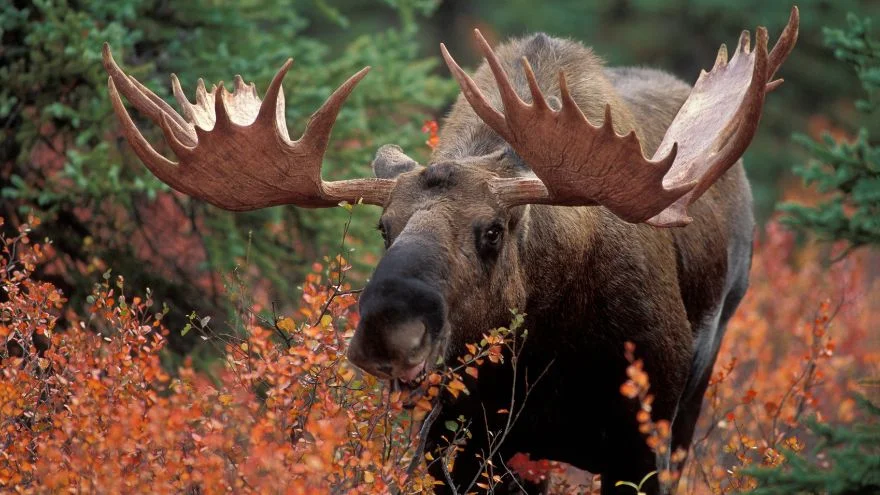There are several species of snakes across North America that are extremely venomous, aggressive, and deadly to humans.
Regardless, certain snakes are relatively harmless and may only result in minor injuries.
However, the likes of the yellow-bellied sea snakes, coral snakes, and eastern diamond rattlesnakes fall into the category of the most venomous snakes in North America.
With summer closing in, snakes are likely to be more common than ever, hence the need to be armed with the right information.
Explored in detail below are the deadliest snakes in North America, based on venom toxicity and potential human fatalities, especially in the absence of medical attention or antivenom.
The Most Venomous Snakes In North America
1. Coral Snake

The new world coral snakes are divided into two genera, namely Micrurus and Micruroides.
The subject of focus is the Eastern Micrurus fulvius and the Western Micruroides euryxanthus, both of which are venomous coral snakes belonging to the scientific family Elapidae.
Both snakes are brightly colored with black and red stripes, along with smaller yellow stripes in smaller circles encircling the body.
However, the eastern species is slightly longer, with average inches falling between 24 to 30 inches but can reach 40 inches.
The western is also long, with an average of 24 inches, yet can surpass 30 inches.
Both snakes hold one of the most potent neurotoxins among snakes in North America.
The silver lining with the eastern and western coral snake bites is that they can’t deliver the full potency of their venom in a single bite.
Approximately 50% of their bites on humans often contain very little or no venom. Nonetheless, this doesn’t play down its threat.
An average coral snake is filled with more than enough venom to kill four full-grown adults with about 4 to 5 mg.
However, these snakes are highly nocturnal; hence the chance of a fatal encounter is low.
If you are bitten by one, immediate medical care is a must as symptoms may not become obvious for hours or a day, but when obvious, they can be rapid in progression.
2. Eastern Diamondback Rattlesnake
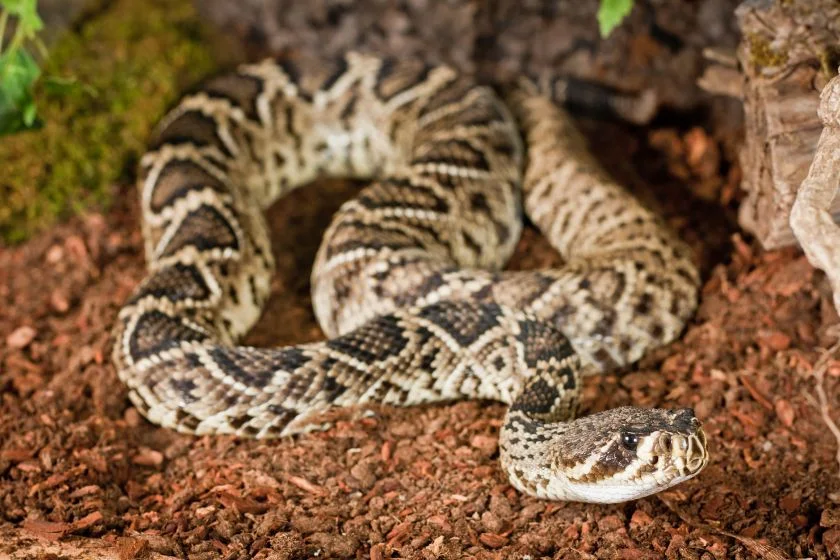
Arguably the biggest venomous snake in North America, the eastern diamondback rattlesnake is a pit viper in the family Viperidae.
It is almost 8 feet in length and weighs about 35 pounds, with a fatality rate of 10% to 20%.
Unlike coral snake bites that are less potent depending on the number of bites, this species delivers a massive 450 mg of venom in a single bite, with less than 150 mg capable of killing a human.
Its venom contains peptides that can cause cardiac failure, thus leading to death.
Most peculiar of the eastern diamondback is that it can strike from just a third of its length and has the longest fangs of any rattlesnake species.
Dry pine forests, sandhills, hammocks, swamps, oak habitats, and sandy mixed woodlands are all habitats of the eastern diamondback.
It can be easily identified by its black diamond patterns edging yellow border skin.
While being dangerous, this snake, when threatened, will retreat, usually slithering backward to face its attacker, but wouldn’t hesitate to strike repeatedly to defend itself.
3. Eastern Copperhead

Yet another pit viper, the eastern copperhead, is reddish brown with hourglass markings and known to be non-aggressive.
Typically not more than 37 inches, these snakes are so calm they deliver warning bites without venom or very little amount of it.
However, its tolerance doesn’t make it any less dangerous. When its purposely bites, its venom contains a lethal dose of 100 mg.
It is not as threatening as the eastern diamondback, yet its bite still can cause severe pain, swelling, throbbing, tingling, intense nausea, and even death in the absence of medical care.
There’s also the risk of a secondary infection or allergic reaction.
The habitat of the eastern copperhead includes swampy regions and dens in mixed woodlands and deciduous forests.
4. Western Diamondback Rattlesnake
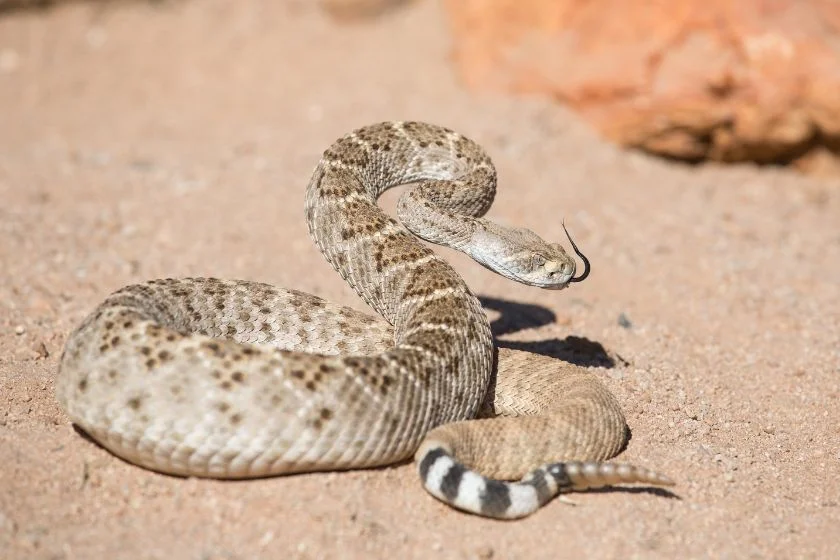
Not the most venomous of most rattlesnakes, yet it is the most murderous, with its being responsible for most snake bite fatalities in northern Mexico and the United States.
It may intrigue your thoughts how one of the least venomous snakes on this list ranks high in the fatality rate.
It produces an immense quantity of venom, thus making up for its less venom potency with a significant amount for as much as 800 mg can be injected in a full envenomation.
The mortality rate of untreated bites falls between 10 to 20 percent.
Its venom contains proteolytic enzymes which destroy structural tissues and cause other damage to the heart, blood cells, and blood vessels.
Having a reputation for being one of the most aggressive rattlesnake species, the western diamondback is usually 4 ft in length but can grow up to 7 ft.
It is a dusty gray-brown in color and lives in a diverse habitat that ranges from rocky mountain areas to sandy-warmed deserts.
5. Cottonmouth
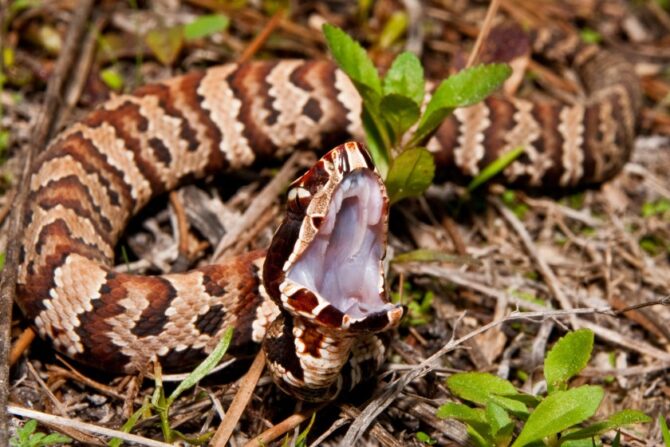
One of the few semiaquatic vipers that exist, the cottonmouth, is also known as the water moccasin or swamp moccasin.
It is particularly named in reminder of its threatened pose in which it gapes open at potential attackers, thus exposing the white lining of its mouth resembling cotton-like color.
It averages 31 to 35 inches, but there are individuals reaching 71 inches.
As with the eastern copperhead, the cottonmouth hesitates to bite, yet when it does, it is much more dangerous than that of the eastern copperhead. Its venom contains cytotoxic that destroys tissues.
Death occurring from its bite is rare; however, it does leave ugly scars and may lead to amputation.
As noted, the cottonmouth is semi-aquatic and therefore is commonly found in swamps, lakes, water streams, and marshes.
6. Mojave Rattlesnake
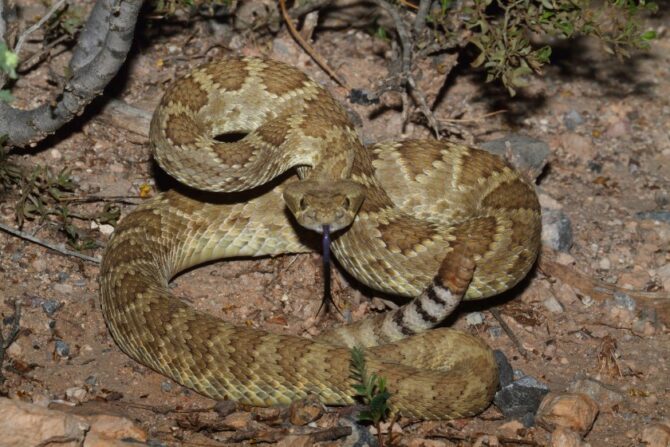
Also known as Mojave Green due to its greenish hue, this snake is famously known for its potent neurotoxic-hemotoxic venom.
Nonetheless, this snake can be anything from a shade of brown to pale green, depending on its habitat. It is usually an average of 3.3 ft but can reach 4.50 to 5 ft.
Most snake venoms are either neurotoxic or hemotoxic. However, with the Mojave rattlesnake, it is made of both.
Its venom destroys not only tissues and muscles but also the nervous system and brain, making it the most deadly rattlesnake ever.
More trickish is that its bites do not seem significant because the bite wound often bleeds little, causing minimal physical distress, and thus can be easily underestimated.
Yet, it is very dangerous, considering its neurotoxin. Symptoms may not become evident until 24 hours after the bite.
High desert, scrub brush, low mountain slopes, and sparse vegetation areas are the typical habitat of the Mojave rattlesnake.
7. Tiger Rattlesnake
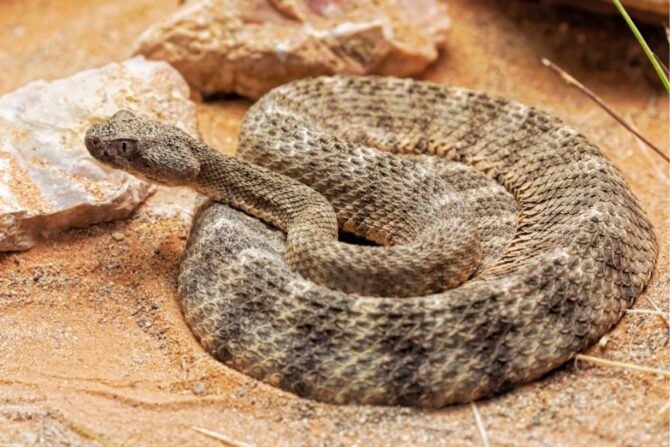
The tiger rattlesnake can be easily identified considering it has the smallest head among rattlesnakes, a small spade shape head, and a pattern of vertical stripes resulting in its being named tiger.
Contrary to its small head, it is incredibly poisonous.
For a fact, its toxicity is the highest among rattlesnake venoms next to the Mojave green and the second highest of all snakes in the Western Hemisphere.
Fortunately, it only injects a small amount of venom, meaning fatalities are very uncommon.
It often inhabits low grassland, tropical deciduous forest, and rocky deserts, among many others, in the southwestern United States and northwestern Mexico.
8. Timber Rattlesnake
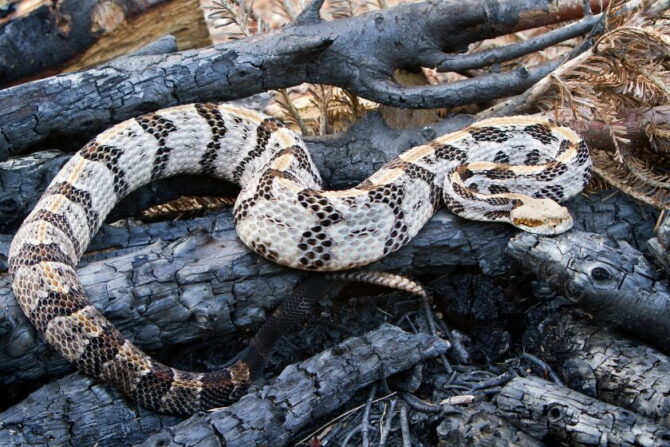
This is yet another venomous rattlesnake with a very toxic bite.
It is usually yellowish-brown or grayish with a dark brown pattern; however, there are individuals that are black.
Ever present in the eastern United States, they are usually 36 – 60 inches in length and, on average, 45 inches weighing 500 to 1,500 g.
Similar to the eastern diamondback, the timber rattlesnake can inject a heavy dosage of venom in a single bite.
With long fangs, being large in size, and being capable of delivering high doses of venom, these snakes’ bites are life-threatening.
9. Yellow-bellied Sea Snake
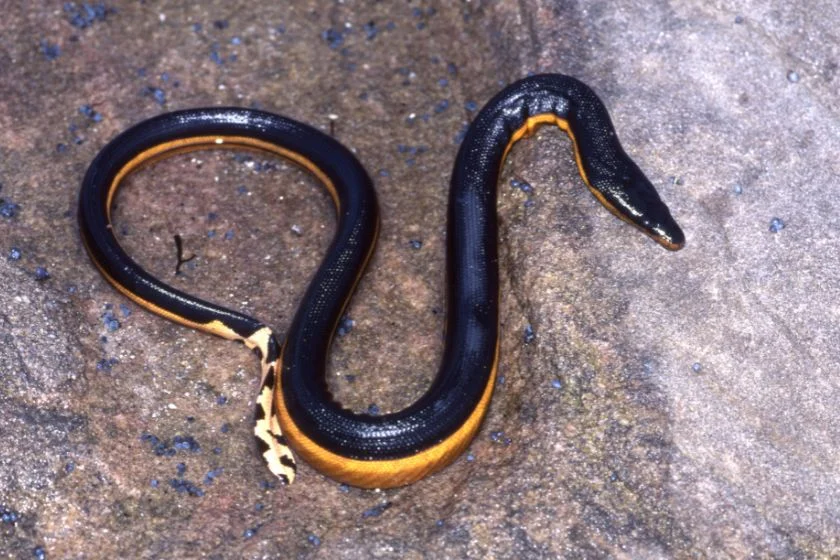
As its name implies, the yellow-bellied sea snake is a bicolor pattern snake having a yellow underbelly and dark brown back.
Its venom is highly potent and contains neurotoxins and isotoxins that can cause skeletal muscle damage, neuromuscular paralysis, and direct renal damage.
The average bite delivers as much as 4.0 mg of venom.
This snake’s habitat is warm ocean water, but it has been reportedly spotted in colder water on the coast of South California and New Zealand.
Non-exclusive to North America, the yellow-bellied sea snake is widely distributed and can be found in almost all oceans across the world, ranging from the Pacific and Atlantic to the Indian Ocean.
They are also a sight in oceans in South America.
Living most of its life in the ocean, the yellow-bellied sea snake seldom ventures into freshwater; thus, there are no reported human deaths from bites.
They can grow as long as 35 inches in length.
10. Massasauga Rattlesnake
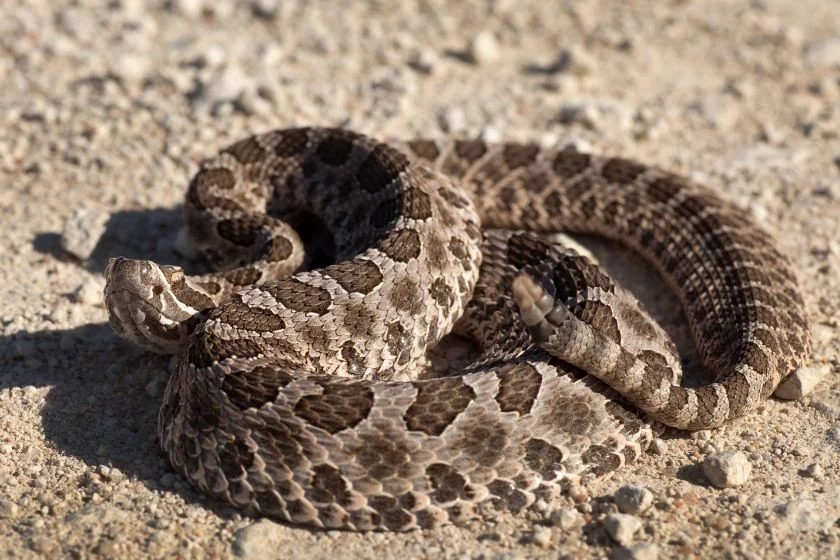
This rattlesnake is found in midwestern North America.
It is most common from southern Ontario to northern Mexico and certain parts of the United States, such as Michigan, Colorado, and Missouri.
Ranging between 24 to 30 inches, the Massasauga rattlesnake has a color pattern that is grey or tan with rows of rounded black or brown spots.
As with most pit viper rattlesnakes, it is venomous. Its venom is cytotoxic; therefore, it destroys tissue, hinders blood flow, and stops blood clotting.
However, this snake is non-aggressive, shy, and steers clear of humans. So, bites are usually unintentional or when felt threatened.
Reported Massasauga snake bites in Ontario as being a result of people accidentally stepping on it or roughly handling it.
Among those treated from the Massasauga snake bite, no fatalities have been reported, yet, there have been reports of death in cases of untreated bites.
Grasslands and marshes are the preferred habitat of the Massasauga rattlesnake.
What to do if you get bitten by a snake
In the unfortunate event you’re bitten by a snake, you need not panic. Gone are the days snake bite equals a death sentence.
All you need is to get medical attention. Yet knowing this, it can be complicated.
People in the tense of it commit all sorts of mistakes that only gravely aggravate the situation. Below are don’ts to abide by in the wake of a snake bite.
1. Do not attempt to capture the snake
You may think getting the snake would be ideal for presenting to your doctor to help determine the right treatment.
This only makes it worse as you risk getting even bitten further.
All you need to do is get a good look at the snake for an accurate description of your doctor. The doctor doesn’t need the snake.
2. Do not underestimate a snake bite
Some snake bite results in deep wounds and a lot of bleeding.
Yet, others may only seem like a minor scratch and thus can be easily written off, especially if the bitten victim feels little or no distress.
How wrong! Some venom effects may not immediately show signs of distress or symptoms.
Notwithstanding how trivia a snake bite might seem, do not be the judge. Ensure you get medical attention and be cleared by a doctor.
3. Do not attempt any form of first aid
There aren’t any helpful first-aid remedies to snake bites. The idea of incision and sucking out the venom might look like a solution, but it isn’t.
The only practical thing you can do is elevate the bitten part to reduce the blood flow there. Other than that, get to a doctor.
4. Be calm
Being bitten by a snake in this age is not a big deal—there are tons of anti-venom.
As long as you get medical help immediately, you will be good.
It will be nothing more than a hilarious tale to retell to your friends or grandkids someday.
Wrap
While there are several species of snakes in this region, this list has illuminated the most venomous snakes in North America.
If you come across any of these deadly snakes, this article has indeed armed you with the right information to identify it easily, and you know better than to walk in its path.
If you get bitten, you know what to do.



